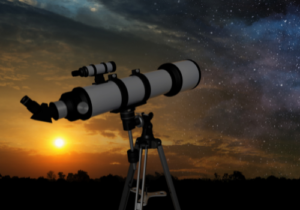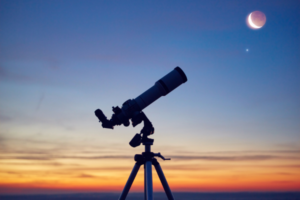What Is A Barlow Lens For A Telescope? What Does It Do?
Disclosure: This post contains affiliate links and I may earn a small commission (at no extra cost to you) if you click through and make a purchase. Thanks in advance – I really appreciate it!
When my friends ask me if they should buy a Barlow lens for their telescope, I always give them the same answer – Hell yeah! A Barlow lens is an extremely useful tool every amateur astronomer should have in his/her arsenal.
Key Takeaways:
What does a Barlow lens do?
A Barlow lens increases the effective focal length of a telescope and therefore increases the magnification of the eyepiece used with that telescope. Barlows are also a cost-effective way of doubling your eyepiece collection. A Barlow lens costs about the same as an eyepiece of comparable quality.
In the rest of this article, I will explain further what exactly a Barlow lens does for your telescope, how you can double your eyepiece collection with just one Barlow, and I will also give you my top recommendations for the best Barlow lens that you can buy online today!
What is a Barlow Lens?
Broadly speaking, the Barlow lens is a cost-effective way to increase the magnification of your telescope.
The most common Barlow is the 2x Barlow lens which doubles the magnification of any eyepiece.
Barlows are also available in 2.5x and 3x magnification.
The Barlow lens was invented in 1833 by Peter Barlow who was an English writer on pure and applied mathematics.
A typical Barlow lens contains a concave lens that is placed between the telescope’s objective lens or primary mirror and the eyepiece.
A Barlow lens is designed to be connected directly to the eyepiece.
As I said mentioned before, a 2x Barlow will double the magnification of the eyepiece it is attached to.
Here’s the calculation:
Using a 10mm eyepiece on a telescope with a 1000mm focal length gives 100x magnification (1000mm / 10mm).
If you attach a 2x Barlow lens to that eyepiece you will double the effective magnification of that eyepiece to 200x.
Similarly, a Barlow lens with 3x magnification will triple the same eyepiece’s magnification to 300x.
How can a Barlow lens double your eyepiece collection?
A Barlow lens doesn’t just increase the magnification of your telescope, It is also a cost-effective way of doubling your eyepiece collection.
For example, If you own a 32mm, 26mm, and 10mm eyepiece, then combining each of these with a 2x Barlow can give you the magnification of a 16mm, 13mm & 5mm eyepiece respectively.
This way with just 1 Barlow lens you can double your eyepiece collection from 3 eyepieces to 6!
How to use a Barlow lens in a telescope?
A Barlow lens is fairly simple to use. A Barlow lens is basically an optical tube whose one end is sized to receive an eyepiece and the other end fits into the focuser of a telescope. To use a Barlow, you will first drop in the Barlow lens into the focuser, then connect your eyepiece to the Barlow.
Like I said, not difficult at all.
Is a Barlow lens worth it?
A Barlow lens is completely worth its price. It’s a great cost-effective way to increase the magnification of your telescope and having just one Barlow lens effectively doubles your collection of eyepieces. They are also great for astrophotography and for observing the night sky in great detail.
Barlows are mostly used in planetary and lunar astrophotography.
With planets because you want to get more details on their surface, such as the bands in Jupiter, Mars ice caps, or the Cassini Division in Saturn’s ring system.
With the Moon, Barlow lenses are great to close in on lunar surface details, such as crater rims and central peaks, and mountain ranges.
How do I choose a Barlow lens?
Barlow lenses are a great and affordable way to magnify the image from your telescope, but you have to choose them carefully.
Here are a few factors that you should keep in mind when selecting a Barlow lens.
1. Make sure that the Barlow fits the tube of your eyepieces.
When selecting a Barlow lens it is critical that you select one with a barrel size that will fit the eyepieces you are going to use it with.
Most tubes come in one of two standard sizes, either 1.25” or 2”, so finding the one that fits won’t be a problem.
It is important that your Barlow lens has the same barrel size as the eyepiece you are going to connect it to.
2. Go with the standard 2x magnification.
Although, Barlow lenses come in 2.5x, 3x, 5x magnifications, I highly recommend going for the standard 2x magnification Barlow, which would be sufficient for most users.
Like I mentioned before, a 2x Barlow means it will double the magnification of any eyepiece it is connected to.
The more powerful Barlow’s may not work well with smaller telescopes. Small scopes don’t pull in much light, so powerful Barlows deliver dim, disappointing images.
Barlow Lens Pros & Cons
Pros
- A cost-effective way to increase the telescope’s magnification.
- Doubles the number of eyepieces you have.
- A must-have for astrophotography.
- It maintains your eyepiece’s eye relief while increasing its magnification.
- It costs as much as a good quality eyepiece.
- You can stack Barlow lenses together to get even more power if you have a cheap telescope, which is ideal if you want to get some up close and personal views.
Cons
- Since Barlow is a diverging lens, the cone of light is spread on a larger area, so the image gets dimmer with the increase of the magnification.
- With a Barlow lens, because of the higher magnification and optical resolution, you often need a very precise polar alignment.
- Lower-priced Barlows have fewer or lower quality lenses that can show minor astigmatism and spurious color at the field edges of smaller telescopes.
Can you use a Barlow lens with a diagonal?
You can use a Barlow lens with a diagonal, either by inserting it between the telescope and diagonal or by inserting it between the diagonal and the eyepiece. When an eyepiece is inserted into a diagonal which is inserted into a 2x Barlow. the resulting magnification factor is closer to 3x.
Will a Barlow lens fit any telescope?
A Barlow lens is designed to be used in combination with an eyepiece. Most eyepieces come in one of two standard sizes, either 1.25” or 2”. Make sure that you buy a Barlow lens with a barrel size that will fit the eyepieces you have in your collection.
Where do you place a Barlow lens?
Typically, a Barlow lens is made to be used in combination with an eyepiece.
To use it in your telescope, simply insert the nose of the Barlow where you would usually insert the eyepiece (the diagonal or the focuser) and then connect the eyepiece to the Barlow lens.
Conclusion
Barlow lenses are the wildcard in the tool belt of any astronomer. They will give you access to many more viewing options without having to make a big investment.
A Barlow lens is especially useful if you have a low-powered telescope, and it is often cheaper than buying a new one. As you may have learned by now, you can also combine it with eyepieces to make a super well-powered telescope. Any hobbyist or professional astronomer should at least get one.
Written by:

Kavya Joshi
My love affair with space began in a field in India at the age of 7, when I looked up at the Milky Way for the first time. Ever since, I have been attempting to cram in every fact about the Universe, I can find into my head.
ABOUT US
We are a team of active amateur astronomers, here to help you with all your astronomy and science related needs – this is anything, from reviewing the latest telescopes to be released to talking about gravity and neurons. The Big Bang Optics was started because of our love for astronomy and to help others like us find the best telescope and accessories.
LEGAL DISCLAIMER
The Big Bang Optics is a participant in the Amazon Services LLC Associates Program, an affiliate advertising program designed to provide a means for sites to earn advertising fees by advertising and linking to Amazon.com. The Big Bang Optics also participates in affiliate programs with Clickbank and other sites. The Big Bang Optics is compensated for referring traffic and business to these companies.




